
The Point of the Page...
The purpose of this page is to outline the enormous variety of IPNs structures that
can be formed by varying the components of the system and the chemistry used to form
the IPN. There are two classification schemes used to describe IPNs. Both schemes
are necessary to completely describe the synthesis of any IPN.
IPN Classification by Chemistry
Sequential IPNs
An IPN formed by polymerizing the first mixture of monomer, crosslinking agent, and
initiator or catalyst to form a network. The network is swollen with the second
combination of monomer and crosslinking agent and polymerized to form an IPN.
Click here to see a movie depicting this process.
Simultaneous Interpenetrating Networks (SINs)
An IPN formed by polymerizing two different monomer and crosslinking agent pairs
together in one step. The key to the success of this process is that the two
comonents must polymerize by reactions that will not interfere with one another.
This is often accomplished by polymerizing one network by a condensation reaction,
while the other network is formed by a free radical reaction.
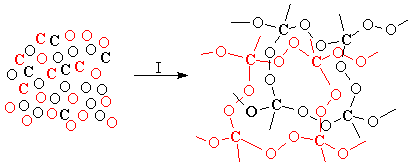
IPNs formed by a simultaneous reaction of components are inherently simpler to make
since there is only one reaction required to make the IPN, while the sequential method
requires two reactions. If the monomers are chosen correctly, SINs can be injection
molded, which is a real big advantage over the sequential IPNs. Sequential IPNs must
be either compression molded or synthesized in bead form. The swelling of the network
in the sequential method can get a little messy too. These factors make simultaneous
IPN reactions a little more appealing to those folks who are looking to commercialize
IPN materials.
The materials produced by the two methods are not exactly the same either. Due to the
intermediate swelling step in the sequential process, the first network formed usually
has an extended chain conformation. The networks in SINs usually have relaxed
conformations. One consequence of this difference is that sequential IPNs ususually swell
less than SINs.
IPN Classification by Structure
Full-IPNs
This is the type of IPN which has been used in the description of IPNs in Ye Olde IPN
Shoppe thus far. It is comprised of two networks that are ideally juxaposed, which generates
alot of entanglements and interaction between the networks. A picture of the molecular
structure of this material is given below on the left. Since it is difficult to
see the structure of the two networks, an alternative geometric structure is given on
the right. The geometric depiction shows the ideal intermeshing of the two networks.
This type of network can be by either a sequential or simultaneous process.
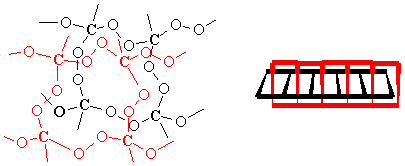
Homo-IPNs
This IPNs are a special type of full-IPNs, where both polymers used in the networks are
the same. They are usually sequential IPNs. They were one of the first types of IPNs to be
commercialized and they are used as model materials for theoritical work.
Semi- or Pseudo-IPNs
One of the components of these IPNs has a linear structure instead of a network structure.
A molecular and geometric depiction of this structure is given below.
The linear component changes some of the properties of the IPN. Some of these IPNs can be
extruded if the linear component is making up a majority of the material. One thing to
keep in mind is that the linear component of the IPN can be removed from the network if
the material is swollen in the appropriate solvent. These types of IPNs can be formed by
either a sequential or simultaneous process. To further complicate the issue, IPNs of this
type that are made by a sequential process are called semi-IPNs and the ones made by a
simultaneous process are pseudo-IPNs.
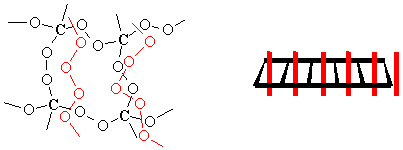
Latex IPNs
One of the problems with most IPNs is that they can't be molded after they are formed since
they are thermosets. One way of getting around this problem is to use a latex IPN. These
IPNs are formed by an emulsion
polymerization. The
morphology of IPN depends upon how the IPN components are polymerized. Both monomers can be
added at once, which will tend to give you a more uniform morphology in the particles
(a simultaneous IPN formation). The monomers can also be added in stages. For instance
monomer 1 can be polymerized to form a latex and monomer 2 can then be added (a sequential
IPN formation). Depending on
how fast monomer 2 diffuses into the latex, one can get either a homogeneous incorporation
of the monomer into the latex or most of monomer 2 may react near the surface of the latex
particle. If most of monomer 2 reacts near the surface, one has a core-shell morphology. A
TEM picture of a core-shell morphology is shown below. The finished latex particles can be
collected and used as they are or they can be used as a coating. To read more about how
IPN latexes are used in coatings,
click here
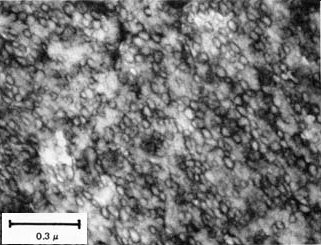
Thermoplastic IPNs
As the name implies, these IPNs are moldable, can be extruded, and can be recycled.
At least one component of these IPNs is usually a
block copolymer, like SBS rubber
. The othe component is typically a
semi-crystalline or glassy polymer. These
IPNs have completely thrown the idea of chemical crosslinks out the window and use physical
crosslinks, like thermoplastic elastomers.
Typical physical crosslinks arise from ionic groups, crystallinity, or glassy domains.
A TEM picture of a thermoplastic IPN comprised of polystyrene and polybutadiene is shown below.
Companies have used these IPNs in a number of applications, since they can be
extruded.
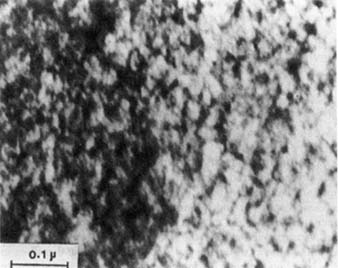
A Few Final Comments...
The extremely diverse number of IPNs that can be formed has lead to the development of a nomenclature
system for unambiguously classifying these materials. It is rather complex but is gradually emerging
in the literature and gaining acceptance among researchers investigating IPNs. Those with
sadomasochist tendancies who are interested in reading more about the nomenclature system can read
about it in the references given in the reference page of Ye
Olde IPN Shoppe.
 How about taking a
little quiz on the material on this page to see how well you learned it.
How about taking a
little quiz on the material on this page to see how well you learned it.
References
- Sperling, L.H. An Overview of Interpenetrating Networks in Polymeric Materials Encyclopedia; Joseph C. Salamone, Ed.
Vol 5; CRC Press: Boca Raton, FL, 1996.







 How about taking a
little quiz on the material on this page to see how well you learned it.
How about taking a
little quiz on the material on this page to see how well you learned it.